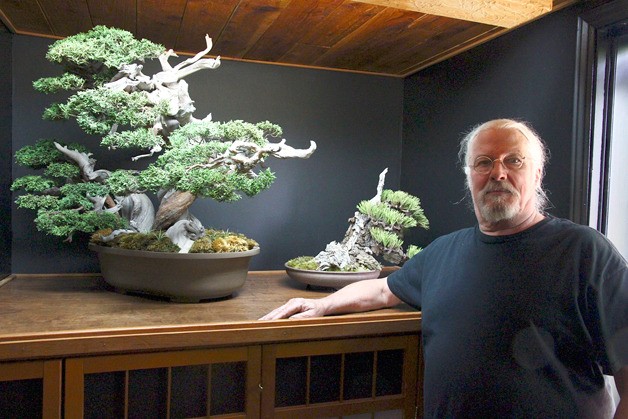As the finest silk flowers are to real blooms, so John Antonia’s “preserved trees” are to the living, miniature potted trees that comprise the ancient Japanese art of bonsai.
More than 20 years ago, Antonia, 69, and his brother Paul, 60, pioneered the practice of attaching preserved evergreen foliage to weathered wood found high on Montana mountainsides, John said during a recent visit.
They have created scores of miniature Rocky Mountain Junipers, using Juniper deadwood hundreds of years old and Juniper foliage kept green, fragrant and pliant by a dip in “Never Say Die,” a substance once sold by taxidermy firm Wasco. That firm has been bought, and “Never Say Die” is not in the new owner’s product catalog.
There are equivalents, but Antonia would just as soon not name them.
“I’d really like to keep it a secret, though as an artist, I’d also like to share it with other artists,” he said.
“So far as I know, no one else is making preserved bonsai to this caliber.”
He drills tiny holes in the deadwood and mounts the preserved foliage with epoxy, which he hand-shapes to simulate a real bud.
Then he paints the area around the bud to match the deadwood. The attachment can “fool even the bonsai master practitioners,” he said. Sometimes he hand-carves the wood to create the effect of greater aging. Each tree takes several weeks.
Antonia, a retired plumber who grew up on Cape Cod, saw a book on bonsai (properly pronounced “bone-SIGH”) 30 years ago and “was stung. I mean stung hard. I loved it.”
Antonia studied with local bonsai expert Dan Robinson at Elandan Gardens in Bremerton. When Paul moved to Idaho and found deadwood in his mountainside foraging, “the artist in me was intrigued,” he said. “What people were doing then with preserved bonsai was a joke.”
“I knew of a taxidermist who had developed that preservative, and everything clicked.”
Since then, Antonia has made at least 70 preserved bonsai trees, selling or giving away about 30 of them. The roughly 20 trees displayed in his simple, clean-lined Coupeville home aren’t for sale, but he said he’d build one if someone were really interested. It would cost, though.
“A crappy one, made out of chopped-up grapevine with some out-of-proportion foliage stuck onto it is selling online for $750, so I might charge $5,000 for one of mine,” he said.
Real bonsai trees can sell for up to $500,000 in Japan, he said. Based on Chinese practices, bonsai flourished in Japan starting in the sixth century. Fake bonsai is more recent.
Why would anyone want a fake when they could have the real thing?
“A real bonsai is constant work,” Antonia said. “You’re always pinching the foliage, always fertilizing, always transplanting it because the nutrients in the soil go south after a few years. Washing the roots, knowing which ones to cut — It’s a steep learning curve.”
With preserved bonsai, “if someone wants a beautiful tree and doesn’t want to have to worry about it dying, there it is.”
For information, contact John at antonias@frontier.com




